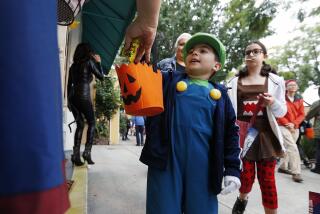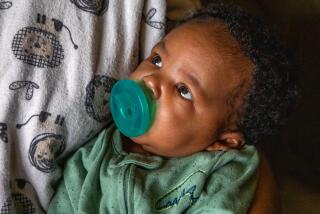Holidays Mean More Hazards for Kids
- Share via
Parents of infants and toddlers may be unaware that the holiday season presents extra hazards, and that specific steps can be taken to minimize them, warns a specialist at New York University Medical Center.
“Three factors combine to make this time of year especially dangerous,” said Dr. George Foltin, director of Pediatric Emergency Services at Bellevue Hospital Center and assistant professor of clinical pediatrics at the center. “One is the creation of newly exciting and colorful surroundings. The second is that infants and toddlers quite normally explore their environment by putting things in their mouths. Third, parents are busy and preoccupied with holiday preparations--just when they need to be especially alert.”
As most parents of infants and toddlers know, once a child is mobile, the house must be “childproofed” by locking away breakables, sharp instruments, detergents and other potentially perilous items. In addition to standard precautions against fire and electrical accidents, a report to be released in the December issue of the center’s Health Letter advises heightened awareness in general and singled out several specific areas:
Morning-after leftovers. Children are highly sensitive to alcohol. Make sure to empty punch bowls and glasses before going to bed.
Electric cords. Biting or chewing on them can cause severe injury. Unplug tree lights when not in use, and cover the outlet with childproof electrical guards. Be watchful of children when tree lights are on, even when other adults are present.
Holiday plants: Holly and mistletoe are both poisonous. Berries of the latter may be toxic if consumed in large amounts; nausea and diarrhea may develop. Both poinsettia and evergreens can cause skin irritation and physical injury to the gastrointestinal tract.
Christmas tree decorations. Potentially dangerous ones include glass or metal objects; angel hair, which is made of spun glass and can cause serious internal injury if swallowed; icicles, which can choke an infant; bubbling lights, which contain methylene chloride, a poisonous chemical, and shellacked cookies and other foodstuffs.
Spray-on snow. The white “snow” itself is inert and harmless, but the various hydrocarbons used as propellants can cause eye, skin or respiratory damage if sprayed in a child’s eyes or mouth.
Gifts. Presents are often left on display after opening. Some may include hazardous materials--for example, after-shaves and colognes, which contain alcohol, and easily swallowed “button” batteries, which contain dangerous caustics. Most toys designed for small children are nontoxic; parents with questions about specific toys should call the U.S. Consumer Product Safety Commission at (800) 638-2772.
Fireplace colors. Chemicals tossed in the fire to create colorful flames are salts of heavy metals, such as copper, arsenic, lead and selenium, and can cause serious illness if swallowed.
Holiday visits. Parents should be particularly alert on family visits to households where there are no small children, since such houses are likely to offer many attractive hazards in a non-childproofed environment.
Foltin adds that syrup of ipecac is helpful as an emetic to induce vomiting of ingested poisons but warns it should be used only under the direction of a physician and must be stored out of the reach of children. If there is a question concerning the toxicity of a swallowed substance, or the proper procedure to follow, telephone your regional poison control center immediately.
More to Read
Sign up for Essential California
The most important California stories and recommendations in your inbox every morning.
You may occasionally receive promotional content from the Los Angeles Times.













